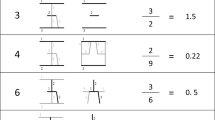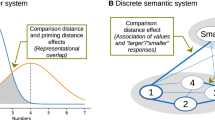Abstract
Are the quantity representations activated by Arabic digits influenced by semantic context? We developed a novel paradigm to examine semantic alignment effects (e.g., Bassok et al. in J Exp Psychol Learn Mem Cogn 34:343–352, 2008) in number comparison. A horizontal word pair (either less more or few many) appeared for 480 ms to prime either relative magnitude (less more) or quantity (few many). Then a horizontal pair of single digits that were either successors (near) or differed by at least four (far) appeared above the word pair. Participants indicated verbally whether or not the word and digit pairs were congruent with respect to left-to-right ascending or descending relative magnitude. The RT advantage for far number pairs compared to near pairs (the distance effect) was greater with magnitude primes (81 ms) than quantity primes (17 ms), demonstrating a semantic alignment effect. This effect disappeared in Experiment 2 in which participants received identical stimuli but named the larger of the two digits and were free to ignore the primes. Nonetheless, mean RT in Experiment 2 was faster with prime and target pairs both ascending or both descending, but only with quantity primes. This prime-dependent order-congruity effect suggests that semantic alignment with respect to numerical order affected number comparison in Experiment 2. The results thereby demonstrate that number comparison exhibits task-dependent semantic alignment effects and recruits distinct numerical representations as a function of semantic context (e.g., Cohen Kadosh and Walsh in Behav Brain Sci 32:313–373, 2009).



Similar content being viewed by others
Notes
We explored analyses that treated reported use of the strategy “anchor on many or more” (n = 12) versus all other reported strategies (n = 12) as a between-participants factor. These analyses did not present any significant effects associated with this strategy classification.
References
Bassok, M. (2001). Semantic alignments in mathematical word problems. In D. Gentner, K. J. Holyoak, & B. N. Kokinov (eds.), The analogical mind: Perspectives from cognitive science (Chapter 12, 401–433). Cambridge: MIT Press.
Bassok, M., Chase, V., & Martin, S. (1998). Adding apples and oranges: Alignment of semantic and formal knowledge. Cognitive Psychology, 35, 99–134.
Bassok, M., Pedigo, S., & Oskarsson, A. (2008). Priming addition facts with semantic relations. Journal of Experimental Psychology: Language, Memory and Cognition, 34, 343–352. doi:10.1037/0278-7393.34.2.343.
Campbell, J. I. D., & Metcalfe, A. W. S. (2009). Numerical abstractness and elementary arithmetic. Behavioural and Brain Sciences, 32, 330–331. doi:10.1017/S0140525X09990495.
Cohen, J. D. (2009). Integers do not automatically activate their quantity representation. Psychonomic Bulletin & Review, 16, 332–336. doi:10.3758/PBR.16.2.332.
Cohen Kadosh, R., & Walsh, V. (2009). Numerical representation in the parietal lobes: Abstract or not abstract. Behavioural and Brain Sciences, 32, 313–373. doi:10.1017/S0140525X09990938.
Dehaene, S. (2003). The neural basis of the Weber–Fechner law: a logarithmic mental number line. Trends in Cognitive Neuroscience, 7, 145–147. doi:10.1016/S1364-6613(03)00055-X.
Fias, W. (2001). Two routes for the processing of verbal numbers: Evidence from the SNARC effect. Psychological Research, 65, 250–259. doi:10.1007/s004260100065.
French, P. L. (1979). Linguistic marking, strategy, and affect in syllogistic reasoning. Journal of Psycholinguistic Research, 8, 425–449.
Ganor-Stern, D., & Tzelgov, J. (2008). Across-notation automatic numerical processing. Journal of Experimental Psychology. Learning, Memory, and Cognition, 34, 430–437. doi:10.1037/0278-7393.34.2.430.
Hasson, U., & Glucksberg, S. (2006). Does understanding negation entail affirmation? An examination of negated metaphors. Journal of Pragmatics, 38, 1015–1032. doi:10.1016/j.pragma.2005.12.005.
Jarmasz, J., & Hollands, J. G. (2009). Confidence intervals in repeated-measures designs: The number of observations principle. Canadian Journal of Experimental Psychology, 63, 124–138.
Jou, J. (2003). Multiple number and letter comparison: Directionality and accessibility in numeric and alphabetic memories. American Journal of Psychology, 116, 543–579. doi:10.2307/1423660.
LeFevre, J., & Kulak, A. (1994). Individual differences in the obligatory activation of addition facts. Memory & Cognition, 22, 188–200.
LeFevre, J., Bisanz, J., & Mrkonjic, L. (1988). Cognitive arithmetic: evidence for obligatory activation of arithmetic facts. Memory & Cognition, 16, 45–53.
Leth-Steensen, C., & Marley, A. A. J. (2000). A model of response-time effects in symbolic comparison. Psychological Review, 107, 62–100. doi:10.1037/0033-295X.107.1.162.
Moyer, R. S., & Landauer, T. K. (1967). Time required for judgements of numerical inequality. Nature, 215, 1519–1520. doi:10.1038/2151519a0.
Opstal, F., Gevers, W., De Moor, W., & Verguts, T. (2008). Dissecting the symbolic distance effect: Comparison and priming effects in numerical and nonnumerical orders. Psychonomic Bulletin & Review, 15, 419–425. doi:10.3758/PBR.15.2.419.
Spellman, B. A., Holyoak, K. J., & Morrison, R. G. (2001). Analogical priming via semantic relations. Memory & Cognition, 29, 383–393.
Turconi, E., Campbell, J. I. D., & Seron, X. (2006). Numerical order and quantity processing in number comparison. Cognition, 98, 273–285. doi:10.1016/j.cognition.2004.12.002.
Wason, P. C., & Johnson-Laird, P. N. (1972). Psychology of reasoning: structure and content. Cambridge, Mass: Harvard University Press.
Wisniewski, E., & Bassok, M. (1999). What makes a man similar to a tie? Stimulus compatibility with comparison and integration. Cognitive Psychology, 39, 208–238. doi:10.1006/cogp.1999.0723.
Zorzi, M., Stoianov, I., & Umiltà, C. (2005). Computational modeling of numerical cognition. In J. I. D. Campbell (Ed.), Handbook of mathematical cognition (pp. 67–84). New York: Psychology Press.
Acknowledgments
This research was supported by a grant from the Natural Sciences and Engineering Research Council of Canada. We thank Arron Metcalfe for helpful comments on an earlier version of the paper.
Author information
Authors and Affiliations
Corresponding author
Rights and permissions
About this article
Cite this article
Campbell, J.I.D., Sacher, S.G. Semantic alignment and number comparison. Psychological Research 76, 119–128 (2012). https://doi.org/10.1007/s00426-011-0331-x
Received:
Accepted:
Published:
Issue Date:
DOI: https://doi.org/10.1007/s00426-011-0331-x




